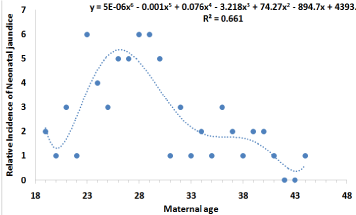Abstract
Neonatal jaundice is a common condition that may occur in up to 60% of neonates. Physiological jaundice may not be a problem and may be recovered without treatment but pathological jaundice may lead to brain damage, mental impairment and even death. Many factors including genetic, biochemical and maternal factors may involve in the development of neonatal jaundice and the data presented here indicated that maternal age may associated with the incidence of neonatal jaundice.
Keywords: Neonatal jaundice; Maternal age; Bilirubin; Pathological neonatal jaundice; newborns
Introduction
Neonatal jaundice is one of the most common conditions in newborns, occurs when excess bilirubin accumulated in the blood or tissue, and was first described in an ancient Chinese medical book “The origin and symptoms of diseases” (Zhu Bing Yuan HouLun, published in 610 AD). It’s estimated that up to 60% of newborns may develop jaundice worldwide [1]. The physiological neonatal jaundice may be caused by relatively lower activities of enzymes like glucuronosyltransferase, shorter lifespan of red blood cells, and lower density of intestinal microflora. The pathological neonatal jaundice may be caused by multiple factors including hepatic dysfunction, hemolysis, and breast-feeding issues [1,2]. The breastfeeding and breast milk are top causal factors in non-hemolytic neonatal jaundice, so the maternal condition may involve in the etiology of neonatal jaundice and this report analyzed the association between the incidence of neonatal jaundice and parental ages. In addition, this is a follow-up study after previous report [3].
Subjects and Methods
The data were obtained from 67 neonatal Jaundice patients hospitalized in Zheng Zhou First People’s hospital during the period from 2011 to 2015, 23 female and 44 male, with the age ranging from 43 minutes to 40 days. The diagnosis and treatment followed standard criteria and protocols [4]. The records of the related patients and related parental information were statistically analyzed with software SPSS 17.0, and the polynomial regression analysis was conducted to show the possible trends.
Results
Among the 329 neonatal patients there are 67 patients suffered solely or partially from neonatal jaundice, and the percentage is 20.36%. The age of the mothers and the number of cases at each age were analyzed. The Figure 1 shows the results.

Figure 1: The incidence of neonatal jaundice is associated with the maternal
age.
The blue plots represent the distribution of the incidence of neonatal jaundice along with maternal age, and the dotted line indicated the polynomial regression trend.
In the regression analysis of neonatal jaundice and maternal age, the highest R2 occurred in polynomial regression, reached 0.661; the peak value was at 26 years old. As reported previously, for the maternal birth age, the highest R2 occurred in polynomial regression and reached 0.9129. The peak value was at 24 years old [3]. Such peak vale shift indicates the association between neonatal jaundice is not simply due to the maternal birth age.
The plots represent the distribution of the neonatal jaundice incidence along with paternal age. The dotted line indicated the polynomial regression to indicate the trend.
The regression analysis indicated that the R2 reached 0.493 in the association of paternal age with the incidence of neonatal jaundice, and the peak value is at 28 years old. This is pretty close to the paternal birth age (data not shown).
Discussion
The imbalance of bilirubin production and removal results in jaundice. For newborns, the liver just begins to take the role of bilirubin conjugation and removal, any factors that affect this process may induce jaundice. For example, the lower vitamin D level in newborns was significantly associated with the incidence of neonatal jaundice [5], maternal obesity is a risk factor for non-hemolytic neonatal jaundice and maternal alloimmunization is a risk factor for hemolytic neonatal jaundice [6]. In addition, the mutations in UGT1A1 and OATP2 genes might also contribute to the development of neonatal jaundice [7]. It’s well known that the quantity and quality of breast milk are the causal factors for neonatal jaundice so the maternal physiological conditions including education level, nutrient supply and age may contribute to the development of neonatal jaundice [8]. In this study, the maternal age showed higher association with the incidence of neonatal jaundice (Figure 1), and the paternal age showed less association with the incidence of neonatal jaundice (Figure 2). This is coincident with the previous report that neonatal pneumonia is associated with maternal age [3]. Together, these studies emphasize the maternal birth age is one of the factors that may involve in the embryo development and the health level of neonates. Pathological neonatal jaundice induces brain damage, mental impairment and even death in newborns [8] so further investigation on this issue should be conducted to provide insights for avoiding the risk factors of neonatal jaundice in the future.

Figure 2: The incidence of neonatal jaundice is weakly associated with
paternal age.
References
- Dean E. Neonatal jaundice, Nursing standard (Royal College of Nursing (Great Britain): 1987). 2016; 30: 15.
- Allen D. Neonatal jaundice, Nursing children and young people. 2016; 28: 11.
- Zhang B, Chen P, Zhu H, Ding Q. The Incidence of Neonatal Pneumonia Associated with Maternal Age. Austin Cell Biol. 2016; 2: 1004.
- Jing HZ. Practical Neonatology, 4th edition. People’s Health Press, 2003.
- Aletayeb SM, Dehdashtiyan M, Aminzadeh M, Malekyan A, Jafrasteh S. Comparison between maternal and neonatal serum vitamin D levels in term jaundiced and nonjaundiced cases. Journal of the Chinese Medical Association: JCMA. 2016.
- Lee BK, Le Ray I, Sun JY, Wikman A, Reilly M, Johansson S. Haemolytic and non-haemolytic neonatal jaundice have different risk factor profiles. Acta Paediatrica (Oslo, Norway: 1992). 2016.
- Min J, Jie L, Caiyun Y, Ying L, Xuefang Y. Gene Mutation in Neonatal Jaundice - Mutations in UGT1A1 and OATP2 Genes. Indian journal of pediatrics. 2016; 83: 723-725.
- Moawad EM, Abdallah EA, Ali YZ. Perceptions, practices, and traditional beliefs related to neonatal jaundice among Egyptian mothers: A crosssectional descriptive study. Medicine. 2016; 95: e4804.
